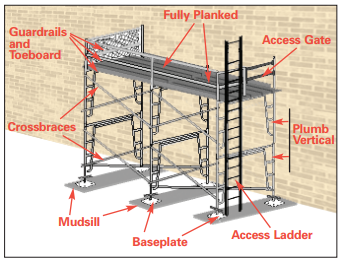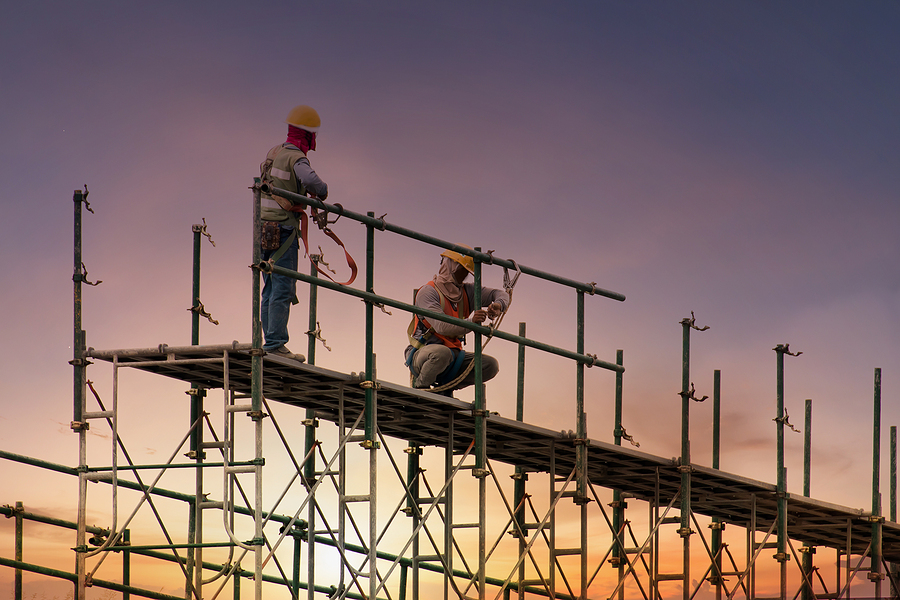Discovering the Various Sorts Of Scaffolding Used in Construction Tasks
The construction industry counts heavily on various kinds of scaffolding to satisfy details task needs, each offering unique benefits and applications. Typical structure scaffolding supplies a strong structure for basic tasks, while put on hold scaffolding is necessary for service high-rise frameworks. Various other options, such as system and rolling scaffolding, accommodate effectiveness and movement, specifically. The cantilever variant proves indispensable in urban settings where room is constrained. Understanding the subtleties of these scaffolding types is vital for maximizing security and performance on building sites, triggering a better examination of their distinct qualities and applications.

Standard Framework Scaffolding
Typical structure scaffolding is one of the most widely used techniques in the building market due to its robustness and versatility. This system includes vertical and straight frameworks that are put together to produce a steady system for employees and materials. The primary parts consist of upright blog posts, straight journals, and angled dental braces, which with each other give a solid structure that can support substantial lots.
Among the vital advantages of traditional framework scaffolding is its adaptability to different building and construction projects, varying from property structures to large commercial frameworks. The modular design enables easy setting up and disassembly, making it reliable for both lasting and short-term jobs. Additionally, the system can be personalized in height and size, accommodating various structure styles and website conditions.
Safety is critical in scaffolding applications, and conventional frame systems are geared up with guardrails and toe boards to avoid drops and make sure worker security. Routine assessments and adherence to safety policies are important in keeping the integrity of the scaffold (Scaffolding). In general, standard framework scaffolding stays a fundamental selection in the building and construction sector, giving a reputable system for labor and enhancing general project effectiveness

Suspended Scaffolding
Suspended scaffolding provides an unique service for construction tasks that need access to raised surface areas, particularly in circumstances where standard structure scaffolding might be not practical. This kind of scaffolding is generally suspended from the roof covering or top levels of a framework, using a system of platforms, wheels, and ropes to produce a functioning area that can be gotten used to numerous heights.
Among the key advantages of put on hold scaffolding is its flexibility. It can be conveniently repositioned or decreased to accommodate adjustments in building demands, making it suitable for jobs such as home window setup, frontage work, and upkeep on skyscrapers. Additionally, the minimal footprint of suspended scaffolding permits far better use ground area in urban atmospheres, where room is commonly limited.
Security is a crucial factor to consider in the usage of put on hold scaffolding. On the whole, put on hold scaffolding gives a reliable and reliable solution for accessing hard-to-reach areas in various construction scenarios, enhancing both efficiency and safety and security on site.
System Scaffolding
System scaffolding, frequently considered as a modern-day solution in the scaffolding market, consists of pre-engineered elements that can be quickly assembled and adapted for numerous building and construction jobs. Scaffolding. This sort of scaffolding is characterized by its modular design, which enables flexibility and efficiency on job sites, accommodating structural demands and different elevations
Generally made from high-strength steel or aluminum, system scaffolding supplies improved sturdiness and stability. The parts include vertical blog posts, horizontal journals, and diagonal braces, which adjoin safely, ensuring a durable framework. The layout commonly incorporates standard installations, simplifying setting up and disassembly processes, consequently decreasing labor time and prices.

Rolling Scaffolding
Moving scaffolding is a flexible choice to typical set scaffolding, designed for mobility and ease of use on construction sites. This type of scaffolding contains a system sustained by frames with wheels, enabling employees to easily move it as required. The movement function dramatically boosts productivity, as it lessens downtime connected with constructing and disassembling taken care of scaffolding.
Usually created from light-weight materials such as aluminum or steel, rolling scaffolding offers a durable yet mobile service for tasks calling for regular repositioning - Scaffolding. It is particularly useful in tasks such as painting, drywall installment, and electric work, where accessibility to various elevations and areas is necessary
Safety and security is vital in rolling scaffolding style, with features such as locking wheels to avoid unplanned motion when in use, and guardrails to safeguard workers from drops. In addition, many designs are adjustable in height, suiting different project demands.
Cantilever Scaffolding

The design of cantilever scaffolding check it out generally involves making use of brackets or arms secured to a structure or framework, allowing the platform to extend exterior securely. Safety and security is paramount; therefore, these scaffolds should be engineered to stand up to different loads and environmental conditions. Normal examination and maintenance are necessary to make certain structural stability and worker safety and security.
Cantilever scaffolding is preferred for its adaptability and reliable use space, making it a popular choice in urban atmospheres where room restraints are common. It promotes simpler accessibility to high elevations, ultimately adding to the total effectiveness of building and construction projects. Just like all scaffolding types, correct training and adherence to security standards are vital for workers making use of cantilever scaffolding.
Final Thought
Standard framework scaffolding offers stability, while put on hold scaffolding supplies convenience for elevated tasks. System scaffolding assists in fast assembly, and rolling scaffolding improves flexibility for differing job atmospheres.
Traditional frame scaffolding provides a strong structure for basic use this link tasks, while put on hold scaffolding is important for work on high-rise structures.Rolling scaffolding is a versatile choice to conventional fixed scaffolding, made for wheelchair and simplicity of usage on construction websites. As with all scaffolding types, correct training and adherence to security standards are critical for employees making use of cantilever scaffolding.
Standard structure scaffolding gives stability, while suspended scaffolding offers versatility for elevated jobs. System scaffolding assists in quick assembly, and rolling scaffolding improves movement for differing job environments.